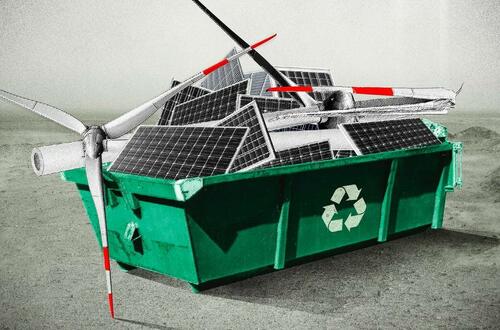US: Green Energy Waste Overlooked In Climate Agenda
Authored by Autumn Spredemann via The Epoch Times

The amount of waste piling up from solar panels and wind turbine blades can be measured in tonnes. And the industry is just getting started.
Almost all spent solar panels in the United States end up in landfills, and many first- and second-generation panels are already tapping out, well ahead of their anticipated 30-year lifespan.
Added to that will be an estimated 9.8 million metric tonnes of dead panels to deal with between 2030 and 2060, according to a study published in Science Direct.
Tossing a solar panel into a U.S. landfill currently costs about $1, maybe $2. To recycle that same panel, the cost balloons to $20 to $30, according to an estimate reported by PV Magazine.
Wind turbine parts present a similar challenge, with thousands of blades having already found their way into dumps and fields in Texas, Wyoming, South Dakota, and Iowa.
It’s no small feat to dump a blade. The length of a single wind turbine blade can be more than 200 feet or longer than the wingspan of a Boeing 747, according to the Department of Energy. Offshore wind rigs are even larger.
Currently, about 7,000 blades are scrapped per year in the United States, according to David Morgan, chief strategy officer for Carbon Rivers, a Tennessee-based recycling centre for advanced materials.
Of all the glass fibre waste that Carbon Rivers receives, wind turbine blades are the most challenging, Mr. Morgan said.
“They’re a very hardy, robust material. They’re large and cumbersome to deal with,” he told The Epoch Times.
“Large wind turbine blades, travel trailers, boat hulls, and other waste streams can be converted into clean, high-quality glass fiber that can be economically reincorporated into your next car, boat, or turbine blade,” the Carbon Rivers website states.
As wind turbine graveyards have turned into viral video content, the wind industry has become more “conversational” about end-of-life solutions, Mr. Morgan said, but it’s not set up for a “composite circular economy.”

When it comes to truly “green” solutions, a “circular economy” is vital, Mr. Morgan said. It’s basically a business model that prioritises the reuse, repair, or regeneration of materials to continue production in as sustainable a way as possible.
He said renewable waste isn’t just an infrastructure problem; there are also legislative gaps.
“Right now, you can largely landfill wind blades. It varies state by state.”
Some companies backing wind energy—particularly those tied to fossil fuel giants such as Shell Global and General Electric—have left critics dubious about whether true sustainability is part of the existing plan.
The U.S. Environmental Protection Agency (EPA), under former President Donald Trump, identified the looming problems with increasing renewable energy waste.
“Without a strategy for their end-of-life management, so-called green technologies like solar panels, electric vehicle batteries, and windmills will ultimately place the same unintended burdens on our planet and economy as traditional commodities,” former EPA administrator Andrew Wheeler said.
Expanding Industry
As the so-called renewable energy industry expands—largely because of massive subsidies from the Biden administration—so does the waste on the back end.
Solar generation capacity is forecast to increase by more than 38 percent in 2024, according to a Dec. 12 report by the Energy Information Administration (EIA), a U.S. government agency. Wind energy capacity is forecast to increase by 4.4 percent.
Despite this notable surge in deployment of renewable energy systems, America’s electric generation in 2022 was primarily (about 60 percent) from fossil fuels—coal, natural gas, petroleum, and other gases, according to the EIA.
Renewable energy sources accounted for about 21 percent and 18 percent was from nuclear energy. An additional fraction was from small-scale solar systems.
Solar panels have a life span of up to 30 years. Understandably, some environmental organizations are raising the alarm.
“If solar and nuclear produce the same amount of electricity over the next 25 years that nuclear produced in 2016, and the wastes are stacked on football fields, the nuclear waste would reach the height of the Leaning Tower of Pisa,” California-based Environmental Progress states.
“The solar waste would reach the height of two Mt. Everests.”
The number of retired wind turbine blades is expected to reach 9,000 per year over the next five years, according to a 2022 analysis published by Chemical and Engineering News.
Mr. Morgan said he’s keeping pace with the inbound waste for now and the company is scaling up operations, including the construction of a large-scale facility in Texas. Carbon Rivers has also broadened its scope into anything “composite-based,” including glass fiber and even aerospace parts.
Another area of waste—electronic waste, commonly known as e-waste—is growing at an exponential rate. It’s the fastest-growing solid waste stream in the world and includes renewable items such as solar panels and electric vehicle (EV) batteries.
Only a small portion is being recycled.
One analysis from 2019 released this year showed that of the 53.6 million tonnes of e-waste produced globally, barely 17 percent was recycled.
“People think plastic is the waste boogeyman … but e-waste is still growing,” Paul Williams, vice president of communications for recycling company ERI, told sources.
Focused on breaking down and recycling all kinds of e-waste, Mr. Williams said ERI maintains a “military-grade” level of data destruction when it comes to electronics.
Privacy protection is a huge concern with e-waste.




